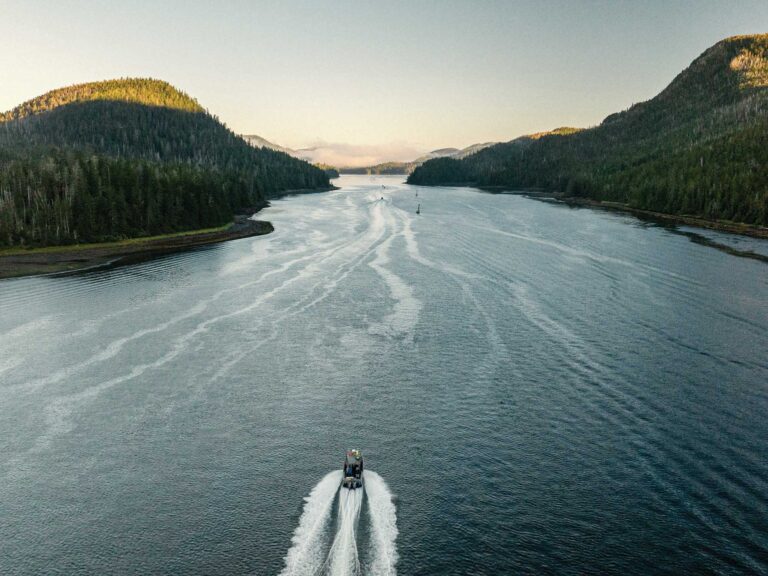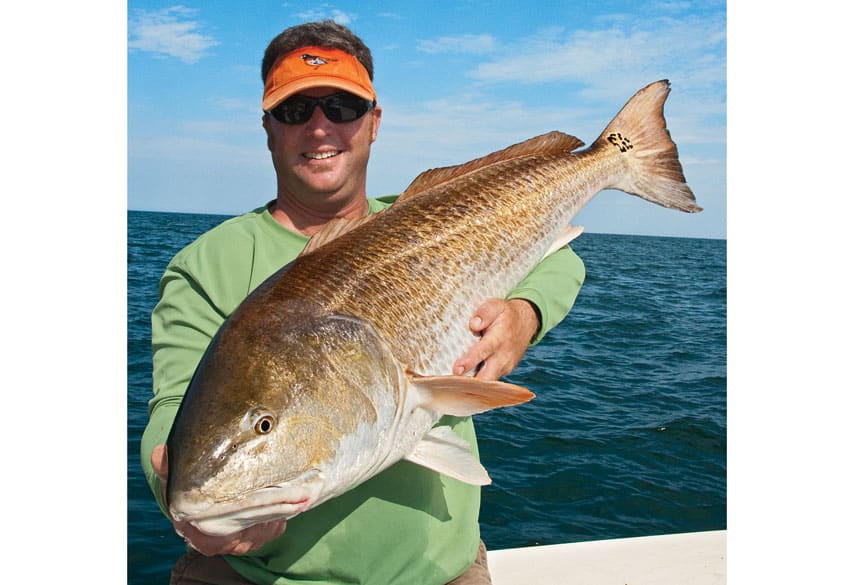
It’s all about the hunt. Searching the water for hours. Spotting that fish. Sneaking up. Making the cast.
The fish lunges, bites. Hook-set. Fish on!
When it all comes together, nothing beats sight-casting. Heart pounding, adrenaline racing, blood rushing, breath stopped. From the skinny-water flats to the open ocean, chasing down a killer that is chasing down its prey is the ultimate challenge. That’s hunting the hunter.
Sight-casting is available anywhere there are fish close enough to the surface to be seen and within casting range.
It takes many forms. Casting to the visible wake of a redfish in shallow, murky water qualifies, as does pitching a bait to a billfish or tuna that has been drawn near the boat in the open ocean.
Looking closely at two classic sight-casting scenarios provides insight into skills that can be applied wherever fish swim within range of a sight-hunting predator.
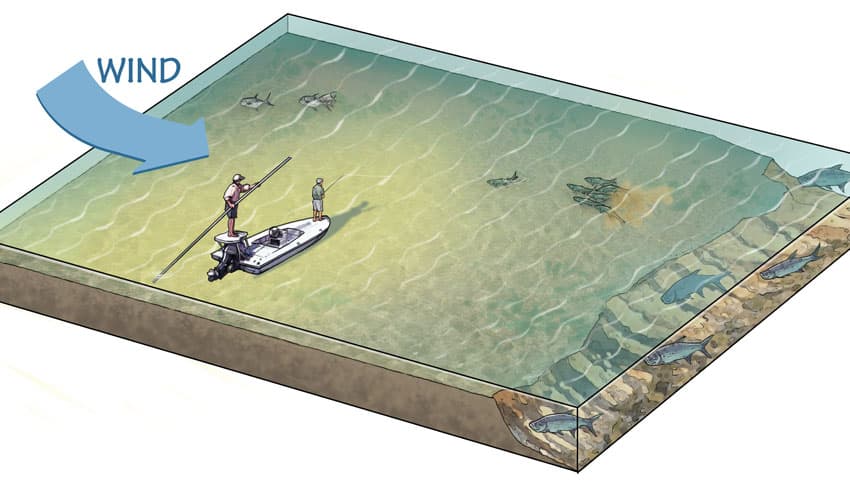
The Source
Classic shallow-water sight-fishing first became a sport 70 years ago in the Florida Keys. Because the tropical flats are so demanding, the skills mastered here will serve you well in any shallow fishing situation. I got my first taste last September in Key West.
The sun was already burning when Capt. Dale Bishop poled his skiff into the mouth of a mangrove-lined creek.
“They should be here any minute,” he said. I searched the water for “ghosts”; that’s how Bishop described bonefish.
The tide filled in as the sun climbed.
“There’s a pair, 10 o’clock!” Bishop directed my eyes.
I saw nothing. “Where?”
“Forty yards, 11 o’clock.”
I squinted; nothing but swaying sea grass and clear water.
“Thirty yards,” Bishop urged.
I spotted two shadows slipping across a patch of sand. My arm responded, flipping the rod to pitch a tiny shrimp at the fish.
But the featherweight bait had another plan, arcing off to the left while the smoky shadows continued right. I’d messed up the cast and missed the fish. I felt deflated.
“Don’t worry,” Bishop said. “There will be more.”
Before I could blow another shot, I drilled him with questions. “These fish are so well camouflaged, a lot of times I see the shadow on the bottom before I see the fish,” he explained
Ghost hunting requires absolute stealth. Bishop moved the push pole like a ninja, careful not to bang the hull or splash water. I did my best to stand still on the casting platform. We spoke in whispers.
This low-key approach extended to Bishop’s tackle too. For bonefish and permit, he gets sneaky with 10-pound-test fluorocarbon leader and a 1/0 mosquito hook. He counters the light tackle with light drag.
Even on giant tarpon he uses a light leader, line and hook. Contrary to what might seem logical, Bishop catches 150-pound tarpon on 60-pound fluorocarbon leader and thin-wire 5/0 hooks. Not only does the light tackle hide Bishop’s intentions, but he thinks the thin hook has a better chance of finding a chink in the tarpon’s armored mouth. “Heavier line and hooks aren’t going to stop one of these fish,” he reasons. “It’s better to hook the fish and break it off than to never hook the fish at all.”
Bishop makes every effort to maximize his advantage on the water. “Before I even launch, I consider the direction of the wind and the angle of the sun to set my course for the day,” he says. Bishop wants the sun over his back and the wind over his angler’s shoulder to facilitate casting. He likes a little chop on the water to break up his silhouette and absorb any sound he might make.
He hates clouds. But overcast skies don’t put him out of business. Even in a deluge, he can go sight-casting. “We’ll search out the shallowest water and look for pushes and fins,” he says. He also looks for the fish on sandy patches or stakes out his boat and chums the fish to him.
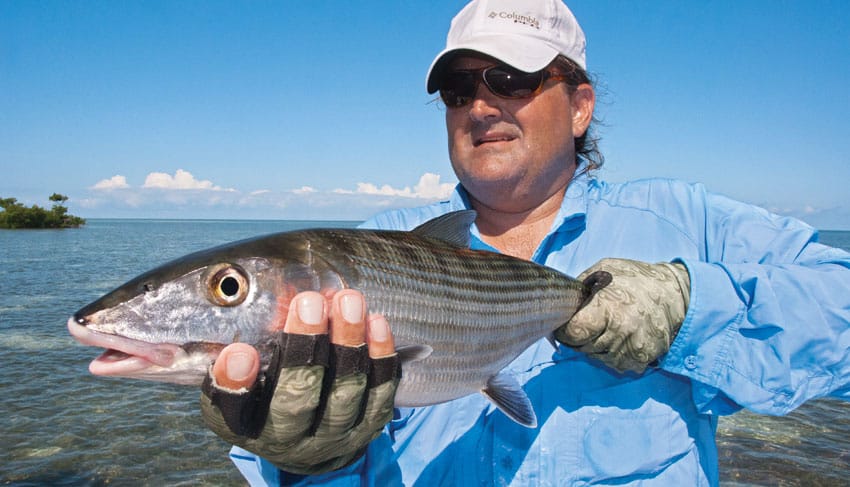
Ultimate Game
With flats-fishing, it’s all about the tide. “I’m looking for a nice flow angle on the flats,” Bishop says, explaining that he wants the tide slowly filling the area. “The fish will follow the tide shallower and shallower.”
Bones will go as shallow as possible. Tarpon will hold in deeper channels. Old heads say permit will feed only on an incoming tide. “That’s not true,” Bishop argues. “There are plenty of places where you can find them on the edge of a channel when the water is dropping.” Once he finds the fish at a specific depth, he searches the area for more.
Luckily, we had perfect sight-casting conditions. It was just up to me to catch one of these fish.
While we searched for the next sortie, I made a couple of practice casts. Good thing our next encounter involved a squadron of bones pushing under the water. I lobbed the bait, and it landed in the general area. Half the fish turned, and one attacked. Talk about living up to its reputation. That fish took me on a wild ride.
Since the birth of sight-casting, the sport has spread from bones, tarpon and permit to stripers, redfish, and even carp and bass. But it’s not only the skinny water that holds potential for fish hunters. Anglers working the open ocean are finding sight-casting opportunities too.
Seeing Is Believing
In my mid-Atlantic home waters, sight-casting has been in vogue for only a few years, and already almost every boat is outfitted with a tower, or at least a stepladder lashed to the deck.
Open-water sight-casting is a little different from shallow-water pursuits. Stealth isn’t as critical, but finding fish still requires the right combination of current and structure.
While I’ve been chasing around cobia and big red drum for a few years, my knowledge leaped considerably after I fished with off North Carolina with Capt. Aaron Kelly out of Oregon Inlet last Memorial Day.
It’s rare that a fishing trip planned weeks in advance coincides with the height of any fish migration. While cobia hang off the Outer Banks through the summer, there are always a few days early in the season when the fish arrive en masse. Last season, those included Memorial Day. The bite had already been going strong the few days before my arrival at the dock “at the crack of 8,” as Kelly said.
By the time we zipped out Oregon Inlet and into the ocean, the sun was high above the horizon. We didn’t go far before Kelly spotted the first cobia. He brought the boat off plane, made a turn and then made a cast. Fish on.
That was all he needed to set his plan for the day. While a growing flotilla of boats ganged up a few miles to the south, Kelly continued to circle the same 3-square-mile area.
“Two advantages to this spot,” Kelly said. First, the area, around the tip of Wimble Shoals, was a cobia magnet. Second, hanging around some distance from the other anglers working the area allowed him to intercept the cobia that were doing the same thing. “A big crowd will push the cobia out to the edges,” he explained.
And it’s not just structure on the ocean bottom that attracts cobia, reds and stripers to the surface. Rips, tide lines, weeds and other flotsam will also hold fish.
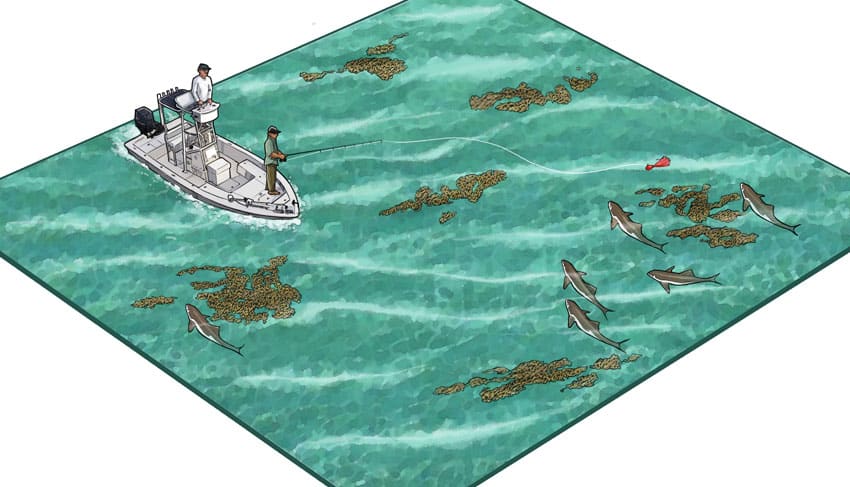
Like Bishop in the Keys, Kelly likes a little chop on the water. “It makes it easier to see the fish as they surf down the waves,” he says.
Kelly also takes the sun and wind into consideration when deciding his strategy for the day. “Each day is different,” he says, “but you can find a pattern and work it.” For instance, if he notices that the fish are heading down-sea, he’ll set his search pattern to cut across the waves at a 25- to 40-degree angle.
Fortunately, we didn’t have to look far. Seeing the first fish sold Kelly on the spot. “Where there’s one, there will be more,” he announced.
He was right.
There was no need to sneak up on these fish. Half the time, the curious cobia turned and swam toward us.
Kelly simply turned the boat without slowing down and closed the distance until the fish was within casting range. Then he launched a 3-ounce bright-red bucktail so it landed 10 feet past the fish and retrieved the lure on the surface so it crossed the cobia’s line of sight.
If the fish didn’t respond, he jigged the bucktail several times. If that didn’t pique the cobia’s interest, Kelly let the lure sink, hoping the fish would follow.
More times than not, that worked. We caught a dozen cobia that day from 40 to almost 90 pounds.
Intercepting the marauding predator. Fooling the fish into feeding. Then fighting it to the death. That’s sight-casting. That’s hunting the hunter.
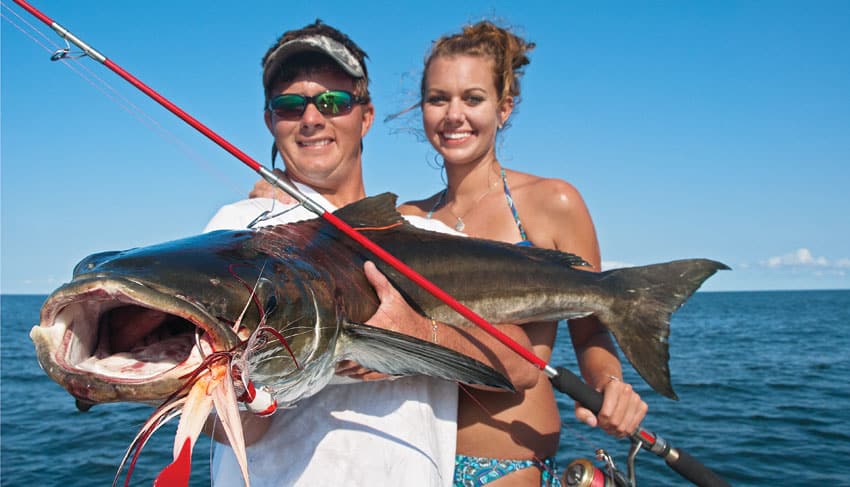
Trip Planner
Flats
Rods: 7-foot medium-light-action spinning rods for bonefish and permit; 7-foot medium-action spinning rods for tarpon.
Reels: Quality reels with strong, reliable drags, 3000-series with 12-pound mono for bonefish and permit, 5000-series spinning reel with PowerPro for tarpon.
Leaders: 3 feet of 10-pound fluorocarbon for bonefish; 6 feet of 60-pound fluorocarbon for tarpon.
Lures and bait: Live shrimp for bonefish and tarpon, crabs for permit, skimmer jigs for bonefish, swimming plugs for tarpon.
Open Ocean
Rods: Medium-heavy 7-foot spinning rod.
Reels: 5000-series spooled with 50-pound PowerPro.
Leaders: 3 feet of 80-pound fluorocarbon.
Lures: 3-ounce bucktails, with broad heads and dressed heavily for cobia; 7-inch curly-tail grub.
The rules of sight-fishing are transferable to wherever you practice the art. The way you intercept fish and the way you present a lure or bait are very similar from one spot to the next, so when you have mastered them in one place, you can expect similar success in any number of different situations, in varied locations and with different species.
What: Bonefish, tarpon, permit, redfish, stripers and snook on the flats; stripers, bluefish, cobia, kingfish, rockfish, billfish, tuna and dolphin offshore.
When: Varies with location.
Where: Wherever game fish move into the shallows to feed or swim shallow enough to be seen.





